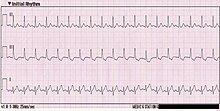Sinus tachycardia
| Classification according to ICD-10 | |
|---|---|
| R00.0 | Tachycardia, unspecified |
| ICD-10 online (WHO version 2019) | |
As sinus tachycardia in which is Medicine an accelerated heart rate designated when doing the electrical excitation ( impulse formation ) in the sinus node is created and through the conduction system is routed to the heart muscle. In adults, a heart rate of more than 100 beats per minute at rest is classified as tachycardia .
etiology
Sinus tachycardia is regarded as physiological, i.e. without any disease value, in infants and small children, during physical exertion or psychological stress.
Pathological (abnormal) sinus tachycardia is divided into primary and secondary forms. The primary form has no apparent cause. In individual cases it is based on a circular excitation in the atrium, which, due to its proximity to the sinus node, creates the image of sinus tachycardia in the electrocardiogram (EKG) ( sinus node reentry ). Inadequate sinus tachycardia caused by a sinus node abnormality may also rarely be present.
Secondary sinus tachycardia often corresponds to a compensation mechanism, including in the case of volume depletion (e.g. in the case of desiccosis or after major blood loss), anemia , fever , pulmonary embolism , heart failure or myocarditis . It can also be an expression of hormonal dysregulation in the context of an overactive thyroid or pheochromocytoma . Even drugs (eg. As agonists in asthma ) and stimulants and intoxicants like caffeine or Ecstasy can lead to sinus tachycardia.
Diagnostics and therapy
The diagnosis of sinus tachycardia is based on the electrocardiogram. Every ventricular action ( QRS complex ) is preceded by an atrial excitation (P wave). Atrial flutter , inadequate sinus tachycardia, and AV node reentry tachycardia must be considered in the differential diagnosis .
For the therapy of this irritation disorder , the recognition and treatment of the cause is crucial. Purely symptomatic therapy should not be used. In primary sinus tachycardia, beta blockers , for example, are used to lower the frequency .
Individual evidence
- ^ A b Ulrich Stierle, Franz Hartmann: Sinus tachycardia. In: Clinical Guide Cardiology. 4th edition. Urban & Fischer, Elsevier, Munich 2008, ISBN 978-3-437-22281-8 , p. 497.
- ^ A b Hans-Joachim Trappe: Sinus tachycardia. In: K. Alexander (Ed.): Thiemes internal medicine. Georg Thieme Verlag, Stuttgart 1999, ISBN 3-13-112361-3 , p. 1236.
- ↑ Ralph Haberl: Sinus tachycardia. In: Ralph Haberl (Ed.): EKG Pocket. 4th edition. Börm Bruckmeier Verlag, Grünwald 2003, ISBN 3-89862-221-5 , p. 153.
